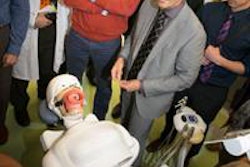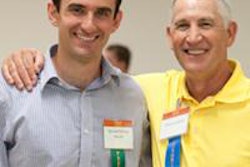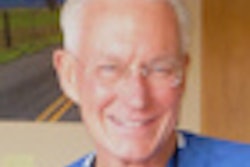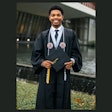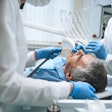
You can get great, affordable dental care at the University of the Pacific (UoP) dental school clinic in San Francisco, with access to a range of specialists and procedures, including restorations, crowns, dentures, cosmetic procedures, and implants.
You just can't be in a hurry.
My dental odyssey began 15 months ago when I arrived at the veritable beehive that is the UoP Arthur A. Dugoni School of Dentistry in the city's swank Pacific Heights neighborhood.
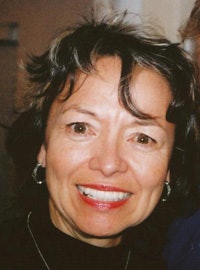 |
| DrBicuspid.com Features Editor Donna Domino with a two-tooth gap among her lower molars. |
Although I have dental insurance, it doesn't cover implants, which I needed after a lower molar had to be extracted. Since it adjoined a molar that had been extracted previously, I was told the two missing teeth formed too wide a gap for a bridge. So I needed two implants.
After learning that the implants plus a needed bone graft would cost me several thousand dollars with a private practitioner, I checked with the UoP dental clinic and found I could get all the work I needed for about half the price.
And so I joined the approximately 10,000 patients who seek treatment every year at UofP's San Francisco dental clinics, which include specialized services for patients with HIV/AIDS, children, emergency care, oral and maxillofacial surgery, orthodontics, orofacial disorders, and patients with special needs. UofP also has dental clinics in Union City, Oakland, and Stockton. Altogether, the four clinics provide treatment for approximately 135,000 patient visits annually, with 506 faculty dentists and 548 students.
The main clinic in San Francisco is a cavernous open room with a maze of about 138 treatment operatories, crowded with patients, students, faculty, and support staff. Dental faculty and specialists roam the floor checking the progress of patients' procedures and answering students' questions. Faculty approval is required at key stages during treatment.
A small x-ray room is tucked in a corner with a never-ending line of students and their bibbed patients waiting their turn. Panoramic x-rays are taken in another room, where patients are seated while the high-tech imaging system rotates around their head. The oral surgery department is divided into several rooms, fully equipped with the latest technology and equipment.
All walks of life
My treatment took place at the San Francisco clinic, where I was paired with then third-year dental student Nicole Kemena, a friendly and extremely capable young woman who would fit my treatments among her classes over the months ahead. (She has since graduated and is a newly minted DDS.)
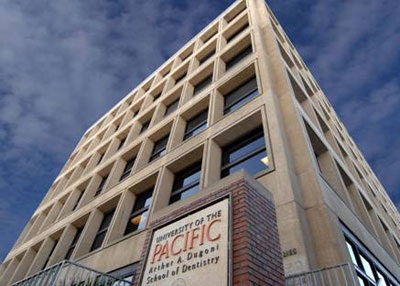
The clinic's large waiting room typically holds about 40 patients at any one time. The students, mostly in their 20s and dressed in blue scrubs, come and call out new patients' names or find and greet them, often in Spanish. I had expected to see mostly poor patients at the clinic, but most looked like me, working people. They represented a broad spectrum: young and old, poor and well-dressed, a lot of minorities.
During her time at UoP, Dr. Kemena's patients came from all walks of life.
"There were people who were well-off, who were looking for aesthetic procedures. Some were in pain and needed treatment," she recalled. "Everyone was very grateful and easy to work with."
The ongoing recession is certainly a factor for many of the clinic's patients. "With the economy being down, people just can't afford their regular dentist," Dr. Kemena noted.
Bert Masangkay, DDS, an assistant professor who graduated from UofP and has supervised students at the clinic for 22 years, said he sees a lot of patients who haven't seen a dentist in a long time. He's also noticed more Medicare patients since California eliminated most adult services under its Denti-Cal program in 2009.
"Since they cut Denti-Cal, a lot of them come in only for emergency treatment," he observed.
Although the procedures at UofP are a fraction of what private practitioners charge, they often run into thousands of dollars, like my two implants and bone graft. The clinic offers payment plans, but they are often a stretch for working people to come up with.
Financial and time constraints can complicate and delay patient treatment, Dr. Kemena noted. "You come up with a plan, then you have to change it because they can't afford it," she explained.
The patient's perspective
The first thing I learned was that I had to be patient. I was often exasperated that it was taking so long. I was embarrassed walking around with such a big gap in my mouth, afraid it was noticeable when I smiled.
 Nicole Kemena, DDS.
Nicole Kemena, DDS.
The bone graft needed time to heal and better anchor the implant post. Then one of the implant posts failed because I wore a temporary bridge over it to hide the gap. One of the most impressive specialists I encountered was Carlos Gonzalez, DDS, an assistant professor of removable prosthodontics, who placed a replacement post and warned that they should remain uncovered to allow proper healing.
Another was Yi-Pin Tsao, DDS, an assistant professor of periodontics, who placed the second implant with notable speed and such proficiency that everyone who later looked at the x-rays remarked on its precision.
As the months passed, Dr. Kemena and I became quite friendly. We talked about our boyfriends, her trip to Italy, what kind of dentistry she wanted to practice, and where she would start looking for work. She is looking for an associate position in Portland, OR, and, for now, wants to be a general practitioner.
During her two years of clinical experience (UofP is the only U.S. dental school to offer a three-year Doctor of Dental Surgery program), Dr. Kemena treated about 60 patients with help from supervising instructors, including some 30 cases in which she performed the procedures herself.
Her most difficult cases included class II or III malocclusions. "They're pretty hard to correct," she noted. "You just can't throw a bunch of crowns on them."
One was a complex care case involving a man who had ground down all of his teeth. The extensive treatment plan had to be done in stages.
"He had ground down his teeth so far you could see the pulp; they were supererupted from all the grinding and some were coming out of their sockets," she explained. "Every tooth needed a crown. But if you crown teeth that are so worn down, it would just open up his bite so much and would be so uncomfortable it wouldn't be possible unless you reintrude the teeth orthodontically. We had to send him to orthodontics to push all the teeth back in before crowns could be placed."
“Sometimes these cases take years, so you can do small things but you can't do the full case.”
— Nicole Kemena, DDS
Many cases, like mine, require years to complete.
"That's the hard thing about being in school," Dr. Kemena said. "Sometimes these cases take years, so you can do small things but you can't do the full case."
Patients with substance abuse problems also presented a challenge. "Sometimes it was hard to get them numb," she noted.
She found working on my double implants to be her most interesting case because it provided rare and valuable clinical experience.
"I really like oral surgery," Dr. Kemena said. "To do implant cases outside dental school is incredibly expensive, and it's incredibly hard to do because it's so time-consuming."
General dentists must take a continuing education course to perform such procedures. "It's great I had the chance to do it in school before I graduated," she said.
End of the road
Darya Ghafourpour, DDS, who oversees restorative procedures, is another UofP alum who works at the clinic one day a week supervising about 40 students, in addition to her private practice.
"Some patients say they want to have a great smile, and then you look at the condition of their mouths and just go, ‘Wow, how can we make that work?' " she explained. "Sometimes you determine that the needed work is too complex for the general care clinic or too complex for student dentists."
The goal is to retain as many of a patient's teeth as possible, she emphasized, but it's not always feasible.
"Patients say, ‘I don't want to lose my teeth,' so you want to help them maintain their teeth or what few they have left," Dr. Ghafourpour said. "But sometimes it ends up being a lot more complex than they would have ever envisioned, and sometimes they're not able or willing to look at the prospect of losing their teeth."
When Dr. Kemena graduated in June, she handed me over to another student, whom I've yet to meet. I'm told that all that's left is coming in to get a shading match for my new bridge and a final bite check. While it's been a long road, I'm finally nearing the end, my final appointment.
And when I walk out with my lovely new bridge covering the two implants, I'll give the biggest smile to everyone on my way out. Sometimes you appreciate things more when they require more time and effort.




